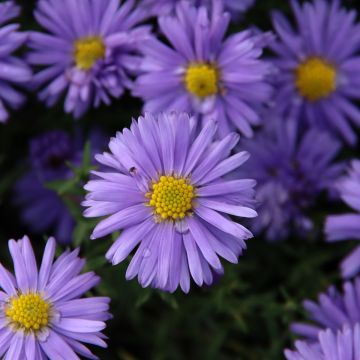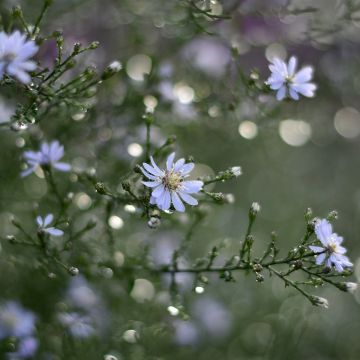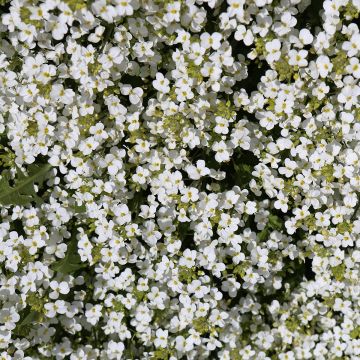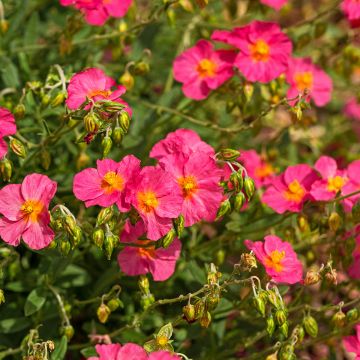

Aster novae-angliae Rosa Sieger
Aster novae-angliae Rosa Sieger
Aster novae-angliae Rosa Sieger
New England Aster, Michaelmas Daisy
This item cannot be shipped to the selected country
Delivery charge from €5.90
More information
Schedule delivery date,
and select date in basket
This plant carries a 12 months recovery warranty
More information
We guarantee the quality of our plants for a full growing cycle, and will replace at our expense any plant that fails to recover under normal climatic and planting conditions.
From €5.90 for pickup delivery and €6.90 for home delivery
Express home delivery from €8.90.
Does this plant fit my garden?
Set up your Plantfit profile →
Description
Aster novae-angliae Rosa Sieger is a New England aster that stands out for the abundance of its flowers and the delicacy of their pink colour. From late summer to the first cold weather, this large perennial plant is covered with clusters of small daisies in a range of pinks, bringing a charming touch to the late season. New England asters are quite resistant to powdery mildew and they thrive in humid climates and heavy, clayey, and fertile soils.
The Asteraceae family, to which asters belong, is mainly characterised by the shape of its flowers, called capitules. Aster novae-angliae are perennial plants that are very hardy (down to -30°C (1°F)), native to the eastern and central regions of North America. This Rosa Sieger variety is of medium size, with flowering stems often reaching up to 1.20m (4ft) in height. Since it blooms abundantly, this perennial often requires staking. The stems branch out in late summer, with each branch producing clusters composed of dozens of flowers that will succeed each other for more than two months between late September and late November. The flower heads resemble small daisies. The ligules or outer petals change from fresh pink to pale pink over the course of the day, surrounding a small yellow centre that turns brown-pink. Flowering will be more generous if the plant does not lack water in summer: the New England aster likes sunny locations but prefers to have its base protected by thick mulch. The woody-based stems bear narrow and hairy leaves, dark green in colour. The above-ground vegetation, deciduous, dries up and dies in winter, to reemerge in spring.
The Aster 'Rosa Sieger' is perfect in borders to extend the flowering season into autumn, but you can also plant it in large pots to brighten up the surroundings of your house. In the ground, create a rustic feel by surrounding asters with tall perennials (Cimicifuga, Gauras, Rudbeckia, perennial sunflowers, inulas) and small bushes (Landscape roses, Perovskia, Caryopteris, dwarf Hydrangeas), plus evergreens like Cotoneaster, Lonicera nitida, or creeping junipers whose foliage will keep the asters company until the end of their flowering period.
Report an error about the product description
Flowering
Foliage
Plant habit
Botanical data
Aster
novae-angliae
Rosa Sieger
Asteraceae
New England Aster, Michaelmas Daisy
Cultivar or hybrid
Other Asters
Planting and care
Plant the 'Rosa Sieger' New England Aster in autumn or spring in ordinary, rich, and well-prepared soil, keeping it moist. It can withstand temperatures as low as -30°C (1°F). It prefers a sunny site but can tolerate partial shade, where it will have a slightly looser habit. It is important to avoid strong winds that could flatten the clumps. It may be necessary to stake the stems in certain cases. Once established, it should not be moved as it does not appreciate change. In a flowerbed, leave at least 50 cm (20in) spacing around the plants; this aster does not tolerate competition from other plant roots. Mulch the soil from June onwards and water in case of heatwaves. New England Asters are not susceptible to powdery mildew. Divide the clumps every three years to ensure abundant flowering. Do not replant the divisions in the same spot, and give them a nutrient-rich soil.
Planting period
Intended location
Care
This item has not been reviewed yet - be the first to leave a review about it.
Foolproof perennials
Haven't found what you were looking for?
Hardiness is the lowest winter temperature a plant can endure without suffering serious damage or even dying. However, hardiness is affected by location (a sheltered area, such as a patio), protection (winter cover) and soil type (hardiness is improved by well-drained soil).

Photo Sharing Terms & Conditions
In order to encourage gardeners to interact and share their experiences, Promesse de fleurs offers various media enabling content to be uploaded onto its Site - in particular via the ‘Photo sharing’ module.
The User agrees to refrain from:
- Posting any content that is illegal, prejudicial, insulting, racist, inciteful to hatred, revisionist, contrary to public decency, that infringes on privacy or on the privacy rights of third parties, in particular the publicity rights of persons and goods, intellectual property rights, or the right to privacy.
- Submitting content on behalf of a third party;
- Impersonate the identity of a third party and/or publish any personal information about a third party;
In general, the User undertakes to refrain from any unethical behaviour.
All Content (in particular text, comments, files, images, photos, videos, creative works, etc.), which may be subject to property or intellectual property rights, image or other private rights, shall remain the property of the User, subject to the limited rights granted by the terms of the licence granted by Promesse de fleurs as stated below. Users are at liberty to publish or not to publish such Content on the Site, notably via the ‘Photo Sharing’ facility, and accept that this Content shall be made public and freely accessible, notably on the Internet.
Users further acknowledge, undertake to have ,and guarantee that they hold all necessary rights and permissions to publish such material on the Site, in particular with regard to the legislation in force pertaining to any privacy, property, intellectual property, image, or contractual rights, or rights of any other nature. By publishing such Content on the Site, Users acknowledge accepting full liability as publishers of the Content within the meaning of the law, and grant Promesse de fleurs, free of charge, an inclusive, worldwide licence for the said Content for the entire duration of its publication, including all reproduction, representation, up/downloading, displaying, performing, transmission, and storage rights.
Users also grant permission for their name to be linked to the Content and accept that this link may not always be made available.
By engaging in posting material, Users consent to their Content becoming automatically accessible on the Internet, in particular on other sites and/or blogs and/or web pages of the Promesse de fleurs site, including in particular social pages and the Promesse de fleurs catalogue.
Users may secure the removal of entrusted content free of charge by issuing a simple request via our contact form.
The flowering period indicated on our website applies to countries and regions located in USDA zone 8 (France, the United Kingdom, Ireland, the Netherlands, etc.)
It will vary according to where you live:
- In zones 9 to 10 (Italy, Spain, Greece, etc.), flowering will occur about 2 to 4 weeks earlier.
- In zones 6 to 7 (Germany, Poland, Slovenia, and lower mountainous regions), flowering will be delayed by 2 to 3 weeks.
- In zone 5 (Central Europe, Scandinavia), blooming will be delayed by 3 to 5 weeks.
In temperate climates, pruning of spring-flowering shrubs (forsythia, spireas, etc.) should be done just after flowering.
Pruning of summer-flowering shrubs (Indian Lilac, Perovskia, etc.) can be done in winter or spring.
In cold regions as well as with frost-sensitive plants, avoid pruning too early when severe frosts may still occur.
The planting period indicated on our website applies to countries and regions located in USDA zone 8 (France, United Kingdom, Ireland, Netherlands).
It will vary according to where you live:
- In Mediterranean zones (Marseille, Madrid, Milan, etc.), autumn and winter are the best planting periods.
- In continental zones (Strasbourg, Munich, Vienna, etc.), delay planting by 2 to 3 weeks in spring and bring it forward by 2 to 4 weeks in autumn.
- In mountainous regions (the Alps, Pyrenees, Carpathians, etc.), it is best to plant in late spring (May-June) or late summer (August-September).
The harvesting period indicated on our website applies to countries and regions in USDA zone 8 (France, England, Ireland, the Netherlands).
In colder areas (Scandinavia, Poland, Austria...) fruit and vegetable harvests are likely to be delayed by 3-4 weeks.
In warmer areas (Italy, Spain, Greece, etc.), harvesting will probably take place earlier, depending on weather conditions.
The sowing periods indicated on our website apply to countries and regions within USDA Zone 8 (France, UK, Ireland, Netherlands).
In colder areas (Scandinavia, Poland, Austria...), delay any outdoor sowing by 3-4 weeks, or sow under glass.
In warmer climes (Italy, Spain, Greece, etc.), bring outdoor sowing forward by a few weeks.
























































